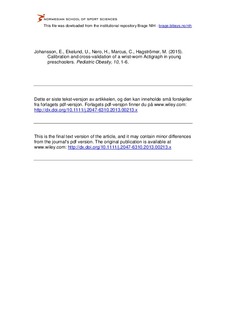| dc.contributor.author | Johansson, Elin | |
| dc.contributor.author | Ekelund, Ulf | |
| dc.contributor.author | Nero, H. | |
| dc.contributor.author | Marcus, C. | |
| dc.contributor.author | Hagströmer, Maria | |
| dc.date.accessioned | 2016-04-06T08:03:56Z | |
| dc.date.available | 2016-04-06T08:03:56Z | |
| dc.date.issued | 2015-02-06 | |
| dc.identifier.citation | Pediatric Obesity. 2015, 10, 1- 6. | nb_NO |
| dc.identifier.uri | http://hdl.handle.net/11250/2384144 | |
| dc.description | Dette er siste tekst-versjon av artikkelen, og den kan inneholde små forskjeller fra forlagets pdf-versjon. Forlagets pdf-versjon finner du på www.wiley.com: http://dx.doi.org/10.1111/j.2047-6310.2013.00213.x /
This is the final text version of the article, and it may contain minor differences from the journal's pdf version. The original publication is available at www.wiley.com: http://dx.doi.org/10.1111/j.2047-6310.2013.00213.x | nb_NO |
| dc.description.abstract | Objective:
To calibrate the Actigraph GT3X+ accelerometer for wrist-worn placement in young preschoolers by developing intensity thresholds for sedentary, low- and high-intensity physical activity. Furthermore, to cross-validate the developed thresholds in young preschoolers.
Methods:
Actigraph GT3X+ was used to measure physical activity during structured activities and free play in 38 children (15–36 months). Activity was video recorded and scored into sedentary, low- and high-intensity physical activity based on Children's Activity Rating Scale (CARS) and combined with accelerometer data using a 5 s epoch. Receiver operating characteristic analysis was used to develop intensity thresholds in 26 randomly selected children. The remaining 12 children were used for cross-validation.
Results:
Intensity thresholds for sedentary were ≤89 vertical counts (Y) and ≤221 vector magnitude (VM) counts per 5 s and ≥440 Y counts and ≥730 VM counts per 5 s for high-intensity physical activity. Sensitivity and specificity were 60–100% for the developed intensity thresholds. Strong correlations (Spearman rank correlation 0.69–0.91) were found in the cross-validation sample between the developed thresholds for the accelerometer and CARS scoring time in all intensity categories.
Conclusion:
The developed intensity thresholds appear valid to categorize sedentary behaviour and physical activity intensity categories in children 2 years of age. | nb_NO |
| dc.language.iso | eng | nb_NO |
| dc.publisher | John Wiley & Sons | nb_NO |
| dc.subject | accelerometry | nb_NO |
| dc.subject | children | nb_NO |
| dc.subject | physical activity | nb_NO |
| dc.subject | toddler | nb_NO |
| dc.title | Calibration and cross-validation of a wrist-worn Actigraph in young preschoolers | nb_NO |
| dc.type | Journal article | nb_NO |
| dc.type | Peer reviewed | nb_NO |
| dc.subject.nsi | VDP::Medical disciplines: 700 | nb_NO |
| dc.subject.nsi | VDP::Medical disciplines: 700::Health sciences: 800 | nb_NO |
| dc.subject.nsi | VDP::Medical disciplines: 700::Health sciences: 800::Nutrition: 811 | nb_NO |
| dc.source.journal | Pediatric Obesity | nb_NO |
| dc.identifier.doi | 10.1111/j.2047-6310.2013.00213.x | |
| dc.description.localcode | Seksjon for idrettsmedisinske fag / Department of Sports Medicine | nb_NO |
